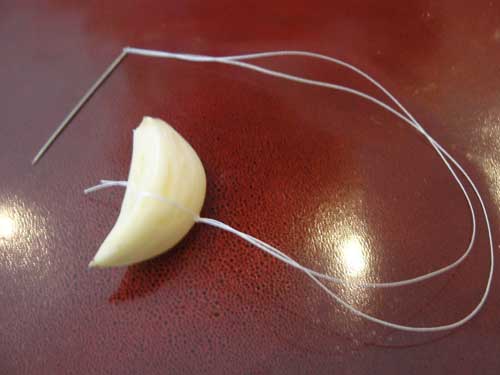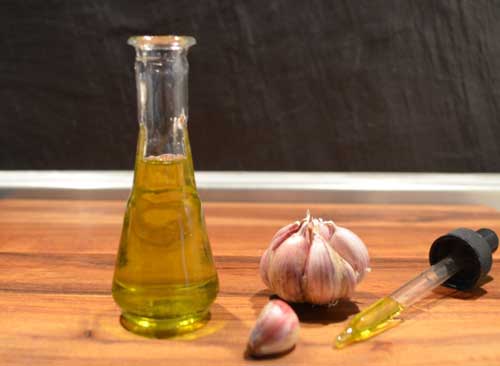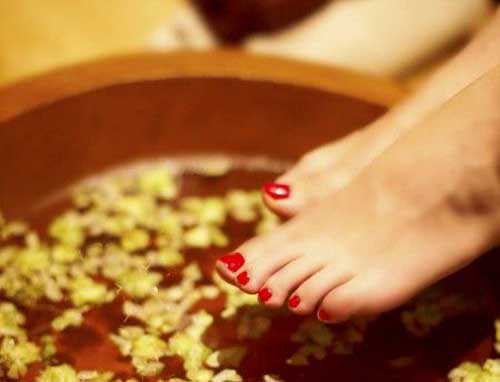
|
|
||||
| Our Pages ABOUT CONSTITUTIONAL MEDICINE
|
Everyone knows what Garlic is. It is surely one of the most beneficial foods/medicines on Earth.
WM Cook writes 'The bulbs have been employed as a condiment and medicine from remote antiquity. They are very stimulating, moderately relaxing, and very diffusible. They excite the mucous secretions, facilitating digestion in sluggish stomachs; improving chronic catarrh, and promoting expectoration' H Felter writes; Lyle writes 'the bulbs are a diffusive stimulant to the mucous membrane throughout, and their influence will be most felt where most needed. In cases of coughs and colds their influence will be felt most upon the lungs and bronchi, for which they may be given internally' M Grieve writes 'As an antiseptic, its use has long been recognized. In the late war it was widely employed in the control of suppuration in wounds. The raw juice is expressed, diluted with water, and put on swabs of sterilized Sphagnum moss, which are applied to the wound. Where this treatment has been given, it has been proved that there have been no septic results, and the lives of thousands of men have been saved by its use' Grieve goes on to say 'It formed the principal ingredient in the 'Four Thieves' Vinegar,' which was adapted so successfully at Marseilles for protection against the plague when it prevailed there in 1722. This originated, it is said, with four thieves who confessed, that whilst protected by the liberal use of aromatic vinegar during the plague, they plundered the dead bodies of its victims with complete security. It is stated that during an outbreak of infectious fever in certain poor quarters of London, early last century, the French priests who constantly used Garlic in all their dishes, visited the worst cases with impunity, whilst the English clergy caught the infection, and in many instances fell victims to the disease' Hoffmann writes 'used daily, Garlic aids and supports the body in ways that no other herb can match. It is an effective antimicrobial, acting on bacteria, viruses and parasites of the alimentary tract. The volatile oil is largely excreted via the lungs, making Garlic useful in infections of the respiratory system, such as chronic bronchitis, respiratory catarrh, recurrent colds and influenza. It may also be helpful in the treatment of whooping cough and as part of a broader approach to bronchial asthma' Hoffmann suggests 'a clove should be eaten for prophylaxis (prevention) during acute infections, 1 clove three times a day is indicated' (equivalent in capsules) King's Dispensatory writes 'Garlic is stimulant, diuretic, expectorant, and rubefacient; it is used both for medical and culinary purposes. The medicinal effects are owing to the absorption of its volatile oil, the stimulating action of which promotes the activity of the various excretory organs, as the skin, kidneys, and mucous membrane of the lungs air-tubes, communicating its odor to their excretions. It has been beneficially used in coughs, catarrhal affections, pertussis, hoarseness, worms, and calculous diseases. When applied along the spinal column and over the chest of infants, in the form of poultice, it is very useful in pneumonia; and placed over the region of the bladder, it has sometimes proved effectual in producing a discharge of urine when retention has arisen from torpor of the bladder. The odor imparted to the breath by garlic and onions, may be very much diminished by chewing roasted coffee grains, or parsley leaves and seeds' The British Herbal Pharmacopoeia (BHP) describes the actions of Garlic as 'diaphoretic, expectorant, spasmolytic, antiseptic, bacteriostatic, antiviral, hypotensive & anthelmintic'. It says it is indicated for 'chronic bronchitis, respiratory catarrh, recurrent colds, whooping cough, bronchitic asthma and influenza'. The BHP suggests combining it with Lobelia in bronchitis and asthma and with Echinacea in conditions associated with bacterial or viral activity. It recommends a dose of 2-4 grams or a tincture at 1:5 in 45% ethanol at a dose of 2-4 mls.
The above are just a few of the proven benefits of Garlic. For anyone that would like to explore some of the research further, there are the titles, authors and when and where published notes on something approaching 700 different studies linked in a PDF here!
Garlic is extremely safe for human consumption and has been used in clinical trials for up to 7 years with no reports of toxicity or adverse reactions. It can be a bit smelly and, as it says in the BHP, only small doses should be given to small children.
For some years now, against this proven and safe way of herbalism, there has been a rising tide of excessive caution and scare-mongering in many parts of the world. The same authorities that, not so long ago, decried herbal medicines as ineffectual, have now taken up a different adversarial position; that they are dangerous substances that should only be prescribed by Doctors, who of course have zero training in them. Unfortunately, the same unnecessary fear and worry has crept into many natural health websites and popular publications on herbs. Herbs that we have safely used for thousands of years, that have no reports of adverse reactions in the medical literature despite widespread use by millions of people, are suddenly described as contraindicated because of something that should have been seen as completely unimportant, or at the utmost a merely theoretical concern, such as a laboratory study on one of the herb's constituents to use an all too common example. I wonder sometimes if the writers of such articles feel that the herb will be more deserving of respect if it is thought to be a little bit dangerous, in other words more like a drug than something that has simply come out of the earth and been used by ordinary people for generations beyond count. There is just so much misinformation about herbal medicine on the internet now. Ludicrous claims and cautions abound in equal measure; it seems like one group are trying to make money out of the public whilst the other are busily trying to scare them off. I have to believe that the kind of reader who takes the time to read pages on herbs that are as extensive as this one is much less likely to be swayed by marketers or misinformers. I hope that you will keep your wits about you if you get conflicting opinions from people who have never really got to know these herbs, who have never worked with them, or learned how to use them safely and effectively. I want to remind you that the reason that herbs can never be patented and owned by any individual or corporation is because they are, and always will be, the People's medicine. They belong to all of us and it is my great hope in sharing this work that you will learn how to use them wisely for yourself, and the people you care for. Be safe, but do not be afraid.
Garlic is both food and medicine and can be recommended to anyone. It is clearly a true tonic if used consistently. Aged Garlic extracts are good for sticky blood and cardiovascular health but for immunity and infection Garlic has to be fresh to be at its best. When you cut or crush Garlic it releases substances that have profound antimicrobial and therapeutic action but those substances quickly degrade after the garlic has been broken open. Here are four ‘recipes’ using fresh Garlic that I have found to be consistently effective.
Women who have been plagued with vaginal thrush or bacterial vaginitis know how heart-sinkingly difficult those problems can be, especially when pharmaceutical options haven’t worked. However, there is a treatment using Garlic that can still succeed where other measures have failed. I first learned of this from Dr Nicky Baillie, a wonderful GP herbalist working out of Auckland, New Zealand. She said that she gets funny looks from women when she tells them how to do it (I can vouch for that too) but that it really works. She’s right, it does. ~ Take one medium sized clove of garlic, then lightly peel it so as to leave a thin ‘skin’ on the garlic. Insert into the vagina and leave overnight (that's where the funny looks come in). 'Yes you can fish it out in the morning' (says Nicky) and apparently she's right* I've had another herbalist, my dear friend and colleague Mary Allan, tell me that she tells her patients to put a needle threaded with dental floss or some other strong thread through the clove and tie a knot at the end of it, a bit like a tampon, and take it out that way. There is a picture just below which shows how this can be done. Another method Mary recommends if she is concerned that her patient might find the treatment too strong is to place the peeled garlic clove in a small piece of muslin cloth before inserting and to tie the thread around the end of the little 'bag'. ~ The next night you have to take an actual tampon, slightly wet it so that it absorbs lots of powder, then roll it in a probiotic (healthy bacteria) powder and also insert and leave overnight. ~ On the third night you repeat the garlic process a second time exactly as you did the first. ~ On the fourth night you repeat the probiotic on the tampon just as you did the first time. A third round is often not necessary but may be used if a problem has been long standing and very difficult to shift. Take a break from the treatment now for at least a few days and see how things go. Most women respond very quickly to this treatment although they may still need to repeat it periodically from time to time if the symptoms start to return.
(the following instructions come from my article on ear-infections found here) I have seen the following treatment be rapidly effective for both children and adults with ear infections and in fact, from many positive experiences with my patients and even in my own family I have a great deal more faith in the ability of this simple treatment to quickly clear an ear infection that I do with antibiotics...
Just as cold can make the pain of an ear-infection worse you may find that your child gets some relief from having some heat up against their ear such as can be obtained from a heated wheat-bag.
This is to kill worms, fungi and bugs that have taken up lodging in the gut.
This is insanely strong but after years of experimenting on myself and others this is the method that I have found that enables the maximum dose of fresh garlic with maximum pleasure. Plan B is to make a bowl of Guacamole with equally ridiculously large amounts of Garlic, then eat it. Note that the subject of bad bugs and what to do to get rid of them is covered in much more detail in my article on dysbiosis here.
This one is for fungal infections of the feet. Take one large whole bulb of Garlic (that means the whole thing, don't peel it, don't remove the outer layers) and put the whole thing through a kitchen blender with about a litre of warm water or as much as you need to soak your foot or feet. You need to soak your foot or infected toes for a good 20 minutes, and you need to be prepared to do this two to three times a week for as many weeks as it takes to clear the infection. Fungal infections of the feet are famously hard to treat but this treatment should work if you persist with it. Be careful to check your skin for any sign of being 'burnt' by the Garlic water. If this happens there will be no lasting damage (you can be sure that there will be much more harm to the fungi than to you) but you should reduce the time you spend in the foot bath rather than the amount of garlic in the mixture.
Please understand that I cannot advise you, including on products or dosage, without seeing you in person in my clinic but for ideas
on how you might find a good herbalist in your area read here |
|
|
|
© 2011 R.J.Whelan Ltd









